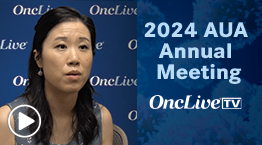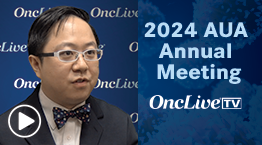Treatment Advances in Triple-Class Refractory/Relapsed Myeloma
EP: 1.Treatment Advances in Triple-Class Refractory/Relapsed Myeloma
EP: 2.INN Melphalan Flufenamide in Triple-Class Refractory/Relapsed MM
EP: 3.HORIZON vs MAMMOTH Explored in R/R Multiple Myeloma
EP: 4.RRMM: INN Melphalan Flufenamide/DEX and Extramedullary Disease
EP: 5.RRMM & High-Risk Cytogenetics: INN Melphalan Flufenamide/DEX
EP: 6.INN Melphalan Flufenamide–DEX for Older Patients With RRMM
EP: 7.RRMM: INN Melphalan Flufenamide After Alkylator Therapy
EP: 8.RRMM: Incorporating INN Melphalan Flufenamide Into Clinical Practice
Paul G. Richardson, MD: The treatment landscape for triple-class refractory multiple myeloma has improved dramatically the last couple of years. We’ve come to recognize that patients who are refractory to not only immunomodulators but also proteasome inhibitors were an exquisite unmet medical need. Then we had the advent of the CD38 monoclonal antibodies, which transformed that therapeutic landscape and dramatically improved outcome.
We face the challenge of patients who have become resistant to an immunomodulator such as lenalidomide and meet that challenge with pomalidomide, but now we have the challenge of patients who are resistant to lenalidomide and pomalidomide. In the past when you’ve been resistant to a proteasome inhibitor like bortezomib, it was obviously the tremendous results from carfilzomib-based therapy and the ixazomib-based treatment. Then of course daratumumab and most recently isatuximab.
When you put all that together, what do you do when all those drugs have unfortunately failed your patients? That becomes a huge challenge.
The very good news is that with the approval earlier this year of isatuximab in combination with pomalidomide, we were given an important new option. We then had real excitement around belantamab mafodotin, which targets BCMA and provides an off-the-shelf ability to deliver monoclonal antibody-drug conjugate to patients. That was really exciting as a monotherapy, and clearly in combination has done the same thing. We got some great data at the ASH [American Society of Hematology] Annual Meeting on combinatorial strategies with belantamab mafodotin. They’re both particularly promising.
The challenge of belantamab, of course, is the keratopathy, and there’s been lots of work going into that process to figure out how to manage the ocular toxicity and minimize it. We have some very nice strategies for doing so, not least of which is the ability to combine the drug with other agents. So change the dose and frequency in a way that allows to hopefully minimize the ocular toxicity or make it as manageable as possible.
Against that backdrop, we’ve got the excitement of not only the incredible data around cellular therapies and BiTEs, or bi-specific T-cell engagers—which are phenomenal—but also the advent of a targeted peptide-drug conjugate called Melflufen. And Melflufen is really interesting because it’s a truly targeted cytotoxic drug that has been developed with the goal of providing a novel mechanism of action in addition to those we’ve already talked about.
Beyond Melflufen, it’s also important to note that at this meeting, in addition to what we saw with bispecific T-cell engagers, CAR [chimeric antigen receptors] T cells, isatuximab, and belantamab mafodotin, we also had some very exiting data on a new mechanism of action: the XPO1 inhibition or the exportin inhibition, or the exportin inhibitor selinexor, which is a first-in-class drug, is orally bioavailable, can be given to patients in combination with other drugs, and can be very effective.
As we think about the relapsed/refractory landscape, we have in the approved space in the last year the isatuximab and belantamab mafodotin. Because we’re recognizing selinexor was approved last year, we also have selinexor in combination with new drugs really making an impact. The best data in that regard are BOSTON, in which we combined selinexor with bortezomib and have been able to show real clinical benefit in the gold standard, which is a randomized phase 3 trial.
As we think about the triple-class refractory landscape, we’ve got lots of exciting new drugs. Selinexor is an XPO1 inhibitor, a totally novel mechanism of action. We’ve got belantamab mafodotin, as I’ve mentioned, most recently. We’ve got obviously the really exciting data around Melflufen, as well as important options to offer our patients.
In the contest of triple-class resistant disease and relapsed/refractory myeloma, another very exciting example of novel targeted therapy that’s coming very rapidly through the development pipeline is that of the CELMoDs—the cereblon E3 ligase inhibitors. At the ASH meeting, we had an outstanding presentation from Dr Niels van de Donk on the combination of iberdomide with a variety of other backbone agents in the treatment of relapsed/refractory disease. We also had a presentation on some of the mechanisms of action of another CELMoD that’s even more potent, we believe, than iberdomide: so-called CC-92480. This particular orally bioavailable drug is particularly promising, not only as a single agent but also in combination.
We have an array of opportunities now for our relapsed/refractory multiple myeloma patients. But obviously in the interest of this evening, I want to specifically focus on just a few. In that spirit, I’d particularly like to talk to you about Melflufen, or as it’s called by medicinal chemistry name, melphalan flufenamide. That sounds like a very conventional chemotherapy. It isn’t.
As just discussed, we’ve got this array of new agents. And as I just mentioned and described some of the real excitement around the CELMoDs, for example, there are a whole variety of approaches going into targeting triple-class resistant, relapsed, and refractory multiple myeloma.
Transcript Edited for Clarity



